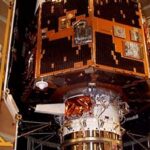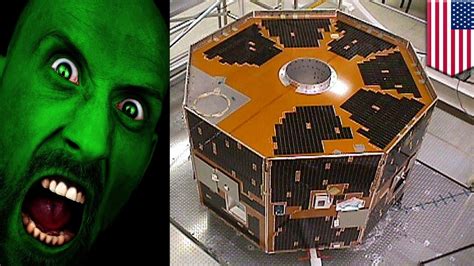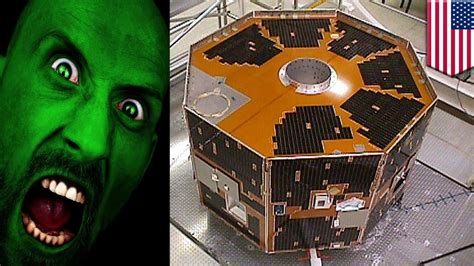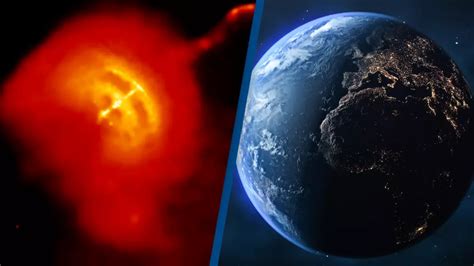
A long-dormant NASA satellite, IMAGE (Imager for Magnetopause-to-Aurora Global Exploration), declared dead in 2005 after communication was lost, has unexpectedly emitted a signal detected across the globe, puzzling scientists and reigniting questions about its potential functionality after nearly two decades of silence.
The re-emergence of the satellite, launched in 2000 to study Earth’s magnetosphere, raises the possibility that it might still be partially operational, though the exact cause and implications of the unexpected transmission remain unclear. The signals, described by some as an “eerie energy blast,” have sparked both excitement and caution within the space science community.
The initial detection occurred in January 2018 by an amateur radio operator, Scott Tilley, who identified the signal as potentially originating from IMAGE. This discovery prompted further investigation by NASA, which involved analyzing the signal characteristics and comparing them to the satellite’s original communication protocols. While preliminary analysis suggested a match, definitively confirming the satellite’s identity and assessing its condition proved challenging due to the prolonged period of inactivity and the degradation of ground-based communication infrastructure.
“It’s like hearing a voice from the past,” commented Dr. James Burch, principal investigator for the IMAGE mission at the Southwest Research Institute, shortly after the signal’s initial detection. “We’re cautiously optimistic, but we need to proceed with careful analysis to understand what’s really happening.”
The unexpected signal from IMAGE underscores the complexities and uncertainties of long-duration space missions and highlights the potential for unexpected events even after a spacecraft is presumed to be non-operational. The incident also serves as a reminder of the enduring value of scientific data and the importance of preserving and analyzing such information even after a mission’s official end.
Mission Background and Objectives
Launched on March 25, 2000, from Vandenberg Air Force Base in California, the IMAGE satellite was designed to provide comprehensive and global views of Earth’s magnetosphere, the region of space surrounding the planet that is controlled by its magnetic field. The magnetosphere plays a crucial role in protecting Earth from harmful solar radiation and is a dynamic environment shaped by the interaction of the solar wind with Earth’s magnetic field.
IMAGE was equipped with a suite of instruments designed to image the magnetosphere in various wavelengths of light, including ultraviolet, extreme ultraviolet, and radio frequencies. These instruments allowed scientists to study the structure and dynamics of the magnetosphere, including the processes that drive auroras, the colorful displays of light that occur in the polar regions.
The mission’s primary objectives included:
- Obtaining global images of the magnetosphere to understand its overall structure and behavior.
- Studying the processes that control the flow of energy and plasma within the magnetosphere.
- Investigating the causes of magnetic storms and substorms, which are disturbances in the magnetosphere that can disrupt communication systems and power grids.
- Understanding the role of the magnetosphere in protecting Earth from harmful solar radiation.
During its operational lifetime, IMAGE provided valuable insights into the workings of the magnetosphere, contributing to a better understanding of space weather and its impact on Earth. The satellite’s data helped scientists to develop more accurate models of the magnetosphere, which are used to predict and mitigate the effects of space weather events.
The Loss of Communication and Subsequent Investigation
In December 2005, NASA lost contact with the IMAGE satellite due to a power failure during a solar eclipse. Despite numerous attempts to re-establish communication, the satellite remained silent, and the mission was officially declared over. The loss of IMAGE was a setback for magnetospheric research, as it left a gap in the observational record and limited scientists’ ability to study the magnetosphere on a global scale.
For years, the satellite was considered a defunct piece of space debris, orbiting Earth silently. However, the unexpected detection of a signal in 2018 reignited interest in the possibility that IMAGE might still be functional, at least in part. The initial detection by Scott Tilley prompted NASA to launch a renewed effort to locate and identify the signal.
NASA’s investigation involved using ground-based radio telescopes to track the signal and analyze its characteristics. The agency also compared the signal’s frequency and modulation with the known communication protocols used by IMAGE during its operational lifetime. While the initial analysis suggested a possible match, definitively confirming the satellite’s identity proved challenging due to several factors:
- The prolonged period of inactivity meant that the satellite’s internal clock and other systems might have drifted, making it difficult to predict its exact communication frequency.
- The ground-based communication infrastructure used to communicate with IMAGE had been decommissioned or repurposed since the satellite’s loss, making it difficult to transmit commands and receive data.
- The satellite’s power system might have degraded over time, limiting its ability to transmit a strong signal.
Despite these challenges, NASA continued to investigate the signal, hoping to confirm the satellite’s identity and assess its condition.
Theories and Speculations
The unexpected re-emergence of IMAGE has led to various theories and speculations about the cause of the signal and the satellite’s potential functionality. Some of the leading theories include:
- Component Failure and Recovery: One theory suggests that a component failure on the satellite may have initially caused the loss of communication in 2005. However, over time, the component may have recovered or been bypassed due to changes in the satellite’s internal environment, such as temperature fluctuations or radiation exposure. This could have allowed the satellite to regain limited functionality and begin transmitting a signal.
- Software Glitch: Another theory proposes that a software glitch may have caused the satellite to enter a dormant state in 2005. The glitch may have been triggered by a specific event, such as a solar flare or a change in the satellite’s orientation. Over time, the glitch may have cleared itself, allowing the satellite to resume its normal operations.
- External Interference: A more skeptical explanation is that the detected signal may not be from IMAGE at all, but rather from another source of radio interference. This could include terrestrial radio transmitters, other satellites, or even natural phenomena such as lightning. However, NASA’s analysis of the signal characteristics suggests that it is unlikely to be from a known source of interference.
- Partial Functionality: Even if the satellite is indeed IMAGE, it is unlikely to be fully functional after nearly two decades of inactivity. The satellite’s instruments may have degraded, its power system may be weakened, and its communication systems may be unreliable. However, even partial functionality could provide valuable data about the magnetosphere and the effects of long-term space exposure on satellite components.
Dr. Patricia Doherty, a space physicist at Boston College, stated, “The idea that a satellite we thought was dead is sending signals again is definitely intriguing. It opens up the possibility that we might learn more about what happened during its silent years and how space environments affect long-term hardware performance.”
Challenges in Re-establishing Communication
Even if the satellite is confirmed to be IMAGE and is found to be partially functional, re-establishing communication and regaining control of the spacecraft would be a significant challenge. Some of the main obstacles include:
- Outdated Technology: The communication systems used by IMAGE are based on technology that is now considered outdated. The ground-based antennas and receivers used to communicate with the satellite may have been decommissioned or repurposed, making it difficult to transmit commands and receive data.
- Orbital Uncertainty: After nearly two decades of inactivity, the satellite’s exact orbital parameters may be uncertain. This makes it difficult to accurately point ground-based antennas towards the satellite and establish a reliable communication link.
- Power Limitations: The satellite’s power system may have degraded over time, limiting its ability to transmit a strong signal and receive commands. This could make it difficult to perform even basic tasks, such as reorienting the satellite or activating its instruments.
- Software Compatibility: The software used to control the satellite may be incompatible with modern computer systems. This could make it difficult to develop and transmit commands to the satellite.
- Unknown Condition of the Spacecraft: The biggest uncertainty is the unknown condition of the spacecraft itself. Without telemetry data, it’s impossible to know the state of the batteries, processors, and other critical components. Attempting to reactivate systems without this knowledge could potentially damage the satellite further.
Potential Benefits of Re-establishing Contact
Despite the challenges, re-establishing contact with IMAGE could offer significant scientific and technological benefits. Some of the potential benefits include:
- Resuming Magnetospheric Research: IMAGE was a valuable tool for studying the magnetosphere, and its data contributed to a better understanding of space weather and its impact on Earth. If the satellite can be reactivated, it could provide valuable new data about the magnetosphere, filling gaps in the observational record and complementing data from other space missions.
- Testing Spacecraft Resilience: The unexpected re-emergence of IMAGE provides a unique opportunity to study the long-term effects of space exposure on satellite components. By analyzing the satellite’s condition and performance, scientists can gain insights into the resilience of spacecraft and develop more robust designs for future missions.
- Validating Orbital Decay Models: Tracking IMAGE can provide valuable data to validate and refine models of orbital decay. Understanding how satellites lose altitude over time is crucial for managing space debris and ensuring the safety of operational spacecraft.
- Advancing Communication Techniques: Attempts to re-establish communication with IMAGE could lead to the development of new communication techniques for interacting with spacecraft in challenging environments. This could include developing more robust communication protocols, improving antenna pointing accuracy, and finding effective ways to communicate with spacecraft that have limited power and processing capabilities.
- Educational Opportunities: The IMAGE situation presents a compelling case study for students and the public, demonstrating the complexities and challenges of space exploration. It can inspire the next generation of scientists and engineers to pursue careers in space science and technology.
The Importance of Space Debris Management
The IMAGE incident also highlights the growing importance of space debris management. As the number of satellites in orbit continues to increase, the risk of collisions and the creation of more space debris also increases. Space debris can pose a threat to operational satellites and spacecraft, and it can also make it more difficult to launch new missions.
The IMAGE satellite, although no longer operational, still occupies a valuable orbital slot. If the satellite cannot be safely reactivated and de-orbited, it could pose a long-term risk to other spacecraft in the region.
“This situation underscores the need for international cooperation on space debris mitigation,” noted Dr. Lisa Ruth Rand, a space historian at the University of Arizona. “We need to develop responsible practices for managing space debris and ensuring the long-term sustainability of space activities.”
Various initiatives are underway to address the problem of space debris, including developing technologies for removing debris from orbit, improving spacecraft tracking capabilities, and establishing international guidelines for responsible space behavior. The unexpected re-emergence of IMAGE serves as a reminder of the importance of these efforts and the need for continued vigilance in managing the space environment.
The Future of the IMAGE Investigation
NASA’s investigation into the IMAGE signal is ongoing. The agency is continuing to analyze the signal characteristics and compare them to the satellite’s original communication protocols. NASA is also working to improve its ability to track the satellite and establish a reliable communication link.
“We are committed to exploring all possible avenues for confirming the satellite’s identity and assessing its condition,” stated a NASA spokesperson. “This is a unique opportunity to learn more about the long-term effects of space exposure on spacecraft and to potentially regain valuable scientific data.”
The investigation is expected to take several months to complete. If the satellite is confirmed to be IMAGE and is found to be partially functional, NASA will then consider options for attempting to re-establish communication and regain control of the spacecraft. However, the agency will proceed cautiously, taking into account the potential risks and challenges involved.
The story of IMAGE serves as a testament to the enduring human fascination with space exploration and the potential for unexpected discoveries even after years of silence. Whether or not the satellite can be fully reactivated, its re-emergence has already provided valuable insights into the complexities of long-duration space missions and the importance of responsible space management.
The scientific community remains hopeful that further investigation will yield more answers about the “eerie energy blast” and the fate of the zombie satellite, IMAGE. The saga also encourages reflection on the responsibility that comes with space exploration, emphasizing the need for careful planning, sustainable practices, and a commitment to preserving the space environment for future generations.
FAQ – Frequently Asked Questions about the IMAGE Satellite Re-emergence
1. What is the IMAGE satellite, and what was its mission?
The IMAGE (Imager for Magnetopause-to-Aurora Global Exploration) satellite was a NASA mission launched in March 2000. Its primary goal was to study Earth’s magnetosphere, the region of space surrounding the planet that is controlled by its magnetic field. It was designed to provide comprehensive global images of the magnetosphere using various instruments, helping scientists understand its structure, dynamics, and its role in protecting Earth from solar radiation and magnetic storms. It aimed to study the processes controlling energy flow within the magnetosphere and investigate the causes of magnetic disturbances.
2. Why was the IMAGE satellite considered “dead”?
In December 2005, NASA lost contact with the IMAGE satellite due to a power failure during a solar eclipse. Despite numerous attempts to re-establish communication, the satellite remained silent. After a period of unsuccessful recovery efforts, the mission was officially declared over, and the satellite was presumed to be non-operational. Its systems were believed to have failed, and the lack of communication led to its classification as a defunct piece of space debris.
3. How was the signal from IMAGE detected in 2018, and what made it surprising?
The signal was initially detected in January 2018 by an amateur radio operator, Scott Tilley. The detection was surprising because the satellite had been silent for over a decade and was presumed to be non-functional. The sudden re-emergence of a signal, potentially matching IMAGE’s communication protocols, sparked renewed interest and investigation by NASA. The “surprise” stemmed from the unexpected nature of the signal after such a long period of silence and the assumption that the satellite’s systems had failed permanently.
4. What are the possible explanations for why IMAGE might have started transmitting a signal again after so long?
Several theories exist. One possibility is that a component failure initially caused the communication loss, but over time, the component recovered or was bypassed due to environmental changes, allowing limited functionality. Another theory suggests a software glitch may have put the satellite into a dormant state, which later cleared itself. A skeptical view is that the signal isn’t from IMAGE but some other form of interference, although NASA believes this is unlikely. The idea of partial functionality suggests the satellite might not be fully operational, but even a limited capacity could provide valuable data.
5. What are the challenges and potential benefits of trying to re-establish communication with IMAGE?
Challenges include outdated communication technology, uncertainty about the satellite’s precise orbital position after decades of inactivity, potential power limitations due to degradation of the power system, and software incompatibility with modern systems. There’s also the unknown condition of the spacecraft itself. The potential benefits are significant. Reactivating IMAGE could resume valuable magnetospheric research, provide insights into the long-term effects of space exposure on spacecraft components, validate orbital decay models, advance communication techniques for challenging environments, and offer educational opportunities. Successfully re-establishing contact would be a significant achievement in space exploration and could contribute to both scientific and technological advancements.

![Oreo’s [Flavor Name] So Good, Petition to Make It Permanent!](https://duniateknoku.com/wp-content/uploads/2025/06/unnamed-file-876-150x150.jpg)


![Oreo’s [Flavor] So Good, Fans May Demand Permanent Status!](https://duniateknoku.com/wp-content/uploads/2025/06/unnamed-file-873-150x150.jpg)




